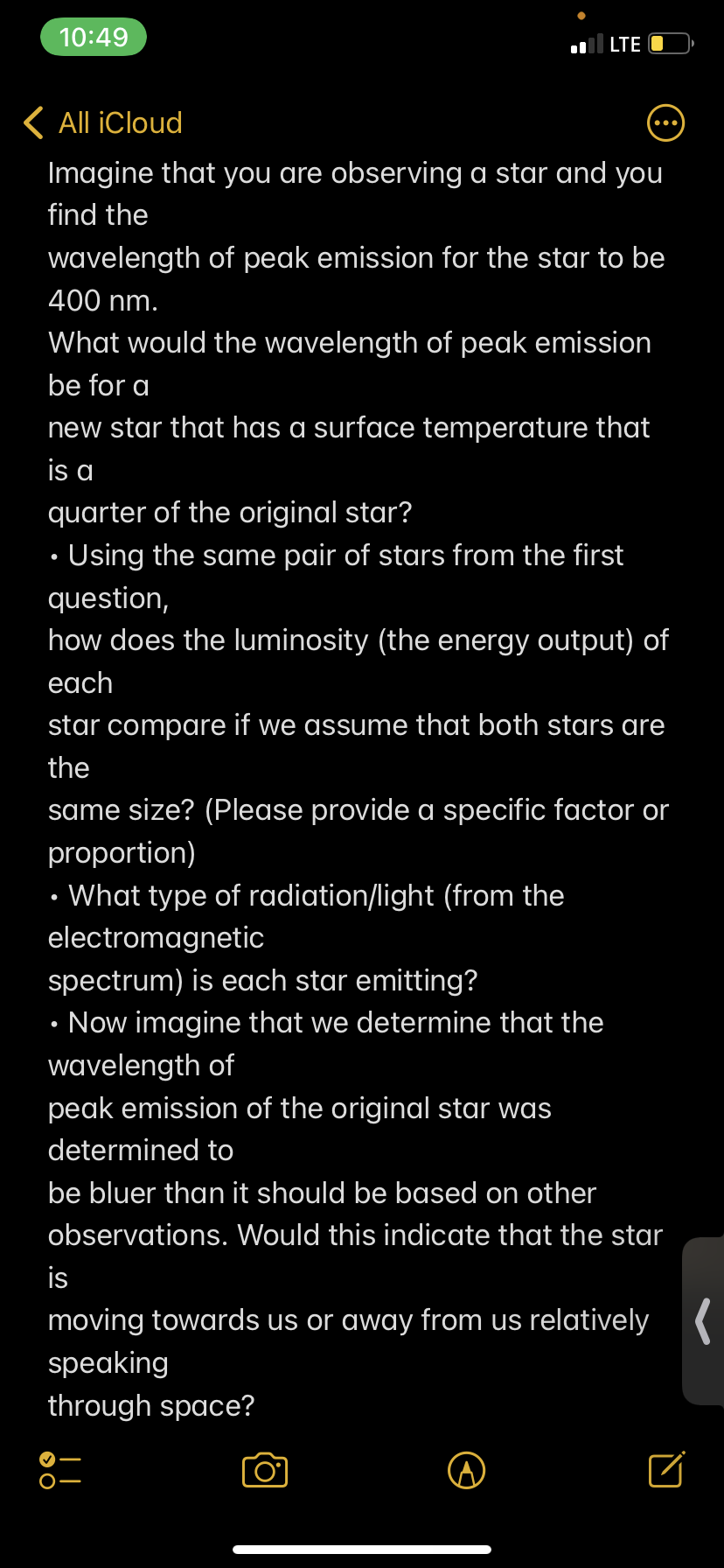Imagine that you are observing a star and you find the wavelength of peak emission for the star to be 400 nm. What would the wavelength of peak emission be for a new star that has a surface temperature that is a quarter of the original star?
Imagine that you are observing a star and you find the wavelength of peak emission for the star to be 400 nm. What would the wavelength of peak emission be for a new star that has a surface temperature that is a quarter of the original star?
Astronomy
1st Edition
ISBN:9781938168284
Author:Andrew Fraknoi; David Morrison; Sidney C. Wolff
Publisher:Andrew Fraknoi; David Morrison; Sidney C. Wolff
Chapter23: The Death Of Stars
Section: Chapter Questions
Problem 41E: One way to calculate the radius of a star is to use its luminosity and temperature and assume that...
Related questions
Question
100%

Transcribed Image Text:10:49
LTE O
< All iCloud
Imagine that you are observing a star and you
find the
wavelength of peak emission for the star to be
400 nm.
What would the wavelength of peak emission
be for a
new star that has a surface temperature that
is a
quarter of the original star?
Using the same pair of stars from the first
question,
●
how does the luminosity (the energy output) of
each
star compare if we assume that both stars are
the
same size? (Please provide a specific factor or
proportion)
What type of radiation/light (from the
electromagnetic
spectrum) is each star emitting?
Now imagine that we determine that the
wavelength of
peak emission of the original star was
determined to
be bluer than it should be based on other
observations. Would this indicate that the star
is
moving towards us or away from us relatively
speaking
through space?
0
Expert Solution
This question has been solved!
Explore an expertly crafted, step-by-step solution for a thorough understanding of key concepts.
Step by step
Solved in 2 steps

Knowledge Booster
Learn more about
Need a deep-dive on the concept behind this application? Look no further. Learn more about this topic, physics and related others by exploring similar questions and additional content below.Recommended textbooks for you

Astronomy
Physics
ISBN:
9781938168284
Author:
Andrew Fraknoi; David Morrison; Sidney C. Wolff
Publisher:
OpenStax

Stars and Galaxies
Physics
ISBN:
9781305120785
Author:
Michael A. Seeds, Dana Backman
Publisher:
Cengage Learning

Stars and Galaxies (MindTap Course List)
Physics
ISBN:
9781337399944
Author:
Michael A. Seeds
Publisher:
Cengage Learning

Astronomy
Physics
ISBN:
9781938168284
Author:
Andrew Fraknoi; David Morrison; Sidney C. Wolff
Publisher:
OpenStax

Stars and Galaxies
Physics
ISBN:
9781305120785
Author:
Michael A. Seeds, Dana Backman
Publisher:
Cengage Learning

Stars and Galaxies (MindTap Course List)
Physics
ISBN:
9781337399944
Author:
Michael A. Seeds
Publisher:
Cengage Learning

Foundations of Astronomy (MindTap Course List)
Physics
ISBN:
9781337399920
Author:
Michael A. Seeds, Dana Backman
Publisher:
Cengage Learning